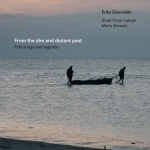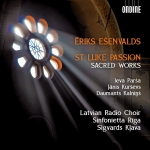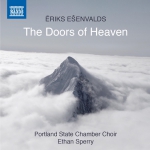The First Tears is based on an Inuit folk tale. The music is a timeless, primeval soundscape, where echoing vocal lines create a sense of eternal space. It is scored for mixed choir, drum, campanelli, jaw harps, and whistles. There is a great deal of word painting that helps the listener envisage the events of the tale: an enormous whale body is described for the first time with a tremendous surge in sound; the whale’s ribs rising up around the Raven like huge ivory columns are depicted by the male voices singing solid blocks of chords while the female voices narrate the story. A sudden blossoming of sound is heard when the Raven sees mysterious light inside the whale. And, of course, the beating of the drum is there too — all adding to the images and sounds present in this tale. While both male and female voices take turns to unfold the story, the sad ending is narrated, without words, by the plaintive sound of a recorder, with an occasional exclamation from a jaw harp.
— from notes by Anastasia Belina-Johnson © 2016


